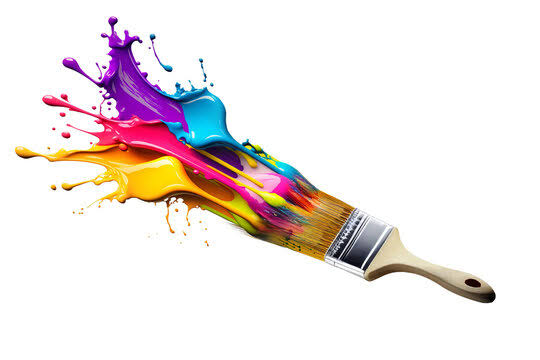Whether you’re a beginner or a seasoned artist, knowing how to choose the right paintbrush and paints can make a world of difference in your art. In this guide, we’ll walk you through everything you need to know about selecting paintbrushes and paints that suit your style, preferences, and artistic goals. Get ready to unlock your creativity and create stunning pieces with confidence!
What You’ll Learn in This Blog:
- Introduction to different types of paintbrushes and paints.
- How to choose the right paintbrush for various painting styles.
- Understanding different types of paints and their uses.
- Tips for maintaining and cleaning paintbrushes.
- Frequently Asked Questions about paintbrushes and paints.
Understanding Paintbrushes: What Makes Them Essential for Art?
Paintbrushes are the tools that allow artists to transfer their vision onto the canvas. They come in different shapes, sizes, and materials, and each type is designed for specific painting techniques. Choosing the right brush can make your strokes more expressive, detailed, or smooth, depending on what you aim to achieve.
Key Types of Paintbrushes:
- Round Brush: Perfect for detailed work, thin lines, and filling in small areas. It’s a versatile choice for watercolor, acrylics, and oil paints.
- Flat Brush: Ideal for bold strokes and covering larger areas. Flat brushes are great when you want to create sharp edges or blend colors smoothly.
- Fan Brush: This brush is used for creating textures like grass, leaves, or clouds. Its spread-out bristles make it excellent for blending and smoothing out paint.
- Detail Brush: These are small, fine-tipped brushes for intricate designs, perfect for adding finishing touches or tiny details.
Materials Matter: Paintbrushes can have synthetic or natural bristles. Synthetic brushes work well with acrylics and watercolors, while natural bristles are better for oil painting because they hold paint better.
Types of Paints: What to Choose for Your Artistic Style?
Just like brushes, choosing the right paint is crucial. Different types of paints behave differently, impacting the texture, color vibrancy, and overall look of your artwork.
Popular Types of Paints:
- Watercolor Paints: Known for their translucent and delicate finish, watercolors are ideal for beginners and artists who love subtle blends. They require special paper to prevent warping.
- Acrylic Paints: Fast-drying and versatile, acrylics can be used on canvas, wood, or paper. They’re water-soluble when wet but become waterproof once dried, making them great for layering and mixed media.
- Oil Paints: These paints offer rich, vivid colors and a smooth, buttery texture. They take longer to dry, which is a plus if you like to blend and manipulate your colors over time. Oil paints require solvents like turpentine for thinning and cleaning.
- Gouache: Similar to watercolor but more opaque, gouache is favored by illustrators for its vibrant colors and matte finish. It’s perfect for creating solid, flat colors without the translucency of watercolors.
Choosing the Right Paint: Your choice depends on your style and the effect you want to achieve. For detailed and delicate work, watercolors or gouache are great. If you’re looking for bold, vibrant colors, acrylics or oils might be your best bet.
How to Properly Care for Your Paintbrushes
A high-quality paintbrush is an investment, and taking care of it ensures it lasts longer. Here are some easy tips to maintain your brushes:
- Clean After Every Use: Rinse the brushes thoroughly with water for water-based paints like acrylics or watercolors. For oil paints, use a brush cleaner or mild soap.
- Store Brushes Vertically: After cleaning, store your brushes with the bristles facing up to avoid bending them.
- Avoid Letting Brushes Soak: Leaving brushes submerged in water or solvent can damage the bristles, causing them to splay out.
- Shape the Bristles: After cleaning, reshape the bristles gently with your fingers to ensure they maintain their original shape.
These simple habits can help extend the life of your paintbrushes, keeping them in top condition for your next creative session.
Conclusion: Unleash Your Creativity with the Right Tools
Choosing the right paintbrush and paints can be a game-changer in your artistic journey. By understanding the different types of brushes and paints available, and learning how to care for them, you can elevate your artwork to new heights. So, grab those brushes, dip them in your favorite colors, and let your imagination run wild!
Frequently Asked Questions (FAQs)
1. What is the best paintbrush for beginners?
For beginners, a set of round and flat brushes in various sizes can cover most painting needs. Synthetic brushes are a good starting point as they are affordable and work well with different paint types.
2. How do I choose between acrylic and oil paints?
Acrylic paints dry quickly and are easy to clean, making them suitable for beginners. Oil paints take longer to dry but allow for more blending time, making them ideal for detailed work and rich textures.
3. Can I use the same brushes for different types of paints?
It’s best to use separate brushes for different paints, especially when switching between water-based and oil-based paints. This prevents residue from one type affecting the other and keeps your brushes in good shape.
4. How do I clean paintbrushes used with oil paints?
Use a brush cleaner or mild soap with water for thorough cleaning. Rinse the brush in a solvent like turpentine to remove excess paint, then wash with soap and water to keep the bristles soft.
5. What are the advantages of natural bristle brushes?
Natural bristle brushes are durable and hold more paint, making them ideal for oil painting. They offer a smoother finish and better control for blending, but they can be more expensive than synthetic options.
6. How often should I replace my paintbrushes?
The frequency of replacing brushes depends on their quality and how well you maintain them. If you notice the bristles splaying or losing their shape, it’s time for a new brush.

